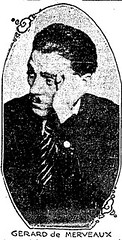April 15, 1927
L adies of Los Angeles! Do your cakes fall? Is your husband weary of tough pot roast? Do the words, "Company’s coming" fill you with dread? Never fear, because Mabelle E. Wyman is here!
adies of Los Angeles! Do your cakes fall? Is your husband weary of tough pot roast? Do the words, "Company’s coming" fill you with dread? Never fear, because Mabelle E. Wyman is here!
Throughout the 1920s, master chef A.L. Wyman answered the questions near and dear to the hearts of Times readers in his weekly column, "Practical Recipes: Helps for Epicures and All Who Appreciate Good Cooking," supplemented by the popular daily feature, "Suggestions for Tomorrow’s Menu." After Wyman’s death in 1926, his widow, Mabelle, immediately took over the columns. Then, she did him one better, announcing free cooking classes to be offered weekly under the auspices of the Los Angeles Times. 
Approximately 1000 Angelenos crowded into Wyman’s lecture room at the Southern California Manufacturers’ Exhibit at 130 S. Broadway for the inaugural class on April 15, some of them sitting on window sills and even under the enamel sink on the stage. Within a week, the Times announced that classes would be offered on Tuesdays and Fridays to accommodate the demand.
Domestic science was a relatively young discipline, and like many burgeoning fields, sought legitimacy in its early days by emphasizing the ‘science.’ Nutrition, economy, efficiency, and tidy presentation were prized, sometimes over taste. While this era in culinary history gave us the icebox cake, it also ushered is a parade of congealed horrors like the tomato frappe (the less said of this unholy mixture of condensed soup and iceberg lettuce the better).
Wyman’s culinary focus was typical for the time, if quirkier. She emphasized meatless dishes, like her Potato and Peanut Sausages, as well as foods grown or produced in Southern California. Popular demonstrations included recipes for Spanish omelettes, cucumber loaf, orange cookies, and the ubiquitous tamale pie.
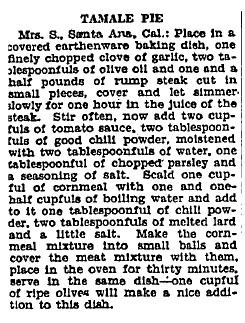 After the first class, Wyman encouraged her audience to submit questions to a question box, and guaranteed answers either during the next class or in her "Practical Recipes" column. While most columns simply answered requests for particular recipes, others were more cryptic. One can only wonder at the query that prompted Wyman to write, "Mrs. S., Los Angeles: I am sorry but the law prohibits my either printing the recipe you ask for or sending it through the mail." Bathtub julep, anyone?
After the first class, Wyman encouraged her audience to submit questions to a question box, and guaranteed answers either during the next class or in her "Practical Recipes" column. While most columns simply answered requests for particular recipes, others were more cryptic. One can only wonder at the query that prompted Wyman to write, "Mrs. S., Los Angeles: I am sorry but the law prohibits my either printing the recipe you ask for or sending it through the mail." Bathtub julep, anyone?
Wyman seems to have been as good as her word, frequently humoring readers who requested recipe reprints. Despite being demonstrated several times at her lectures, and appearing in A.L. Wyman’s posthumous Daily Health Menus (available for check out at the Los Angeles Public Library), Mabelle printed the recipe for tamale pie no less than 10 times during her tenure with the Times.
The classes remained popular until Wyman’s sudden death on January 23, 1931. She was found at her home at 424 Arden Ave. in Glendale (also the mailing address listed in her column for A.L. Wyman Laboratory Kitchen), having suffered a heart attack. Her estate, including a collection of over 200 cookbooks, was auctioned February 8, 1931.
Recommended reading: Laura Shapiro’s Perfection Salad, a lively study of domestic science and city cooking schools around the turn of the century, and Sylvia Lovegren’s Fashionable Food: Seven Decades of Food Fads, a collection of trendy, eyebrow-raising recipes (including one for the ubiquitous tamale pie).
Also of interest: The Food Timeline, a culinary history project created and maintained by a librarian (woot!), featuring landmark foods trends through the ages. Peking duck to hummingbird cake, it’s all here.



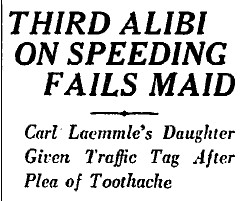 Rosabelle Laemmle, only daughter of Carl Sr., was arrested for speeding in Beverly Hills today. When Officer McBane asked where she was headed in such a big hurry on this Saturday night, she replied, "To the dentist." Unfortunately for Rosabelle, she’d already used that excuse on McBane twice before. Tired of playing the chump, McBane said, "I advise you to have all your teeth pulled out and to present this speeding ticket to Justice of the Peace Etrelinger on the 23rd."
Rosabelle Laemmle, only daughter of Carl Sr., was arrested for speeding in Beverly Hills today. When Officer McBane asked where she was headed in such a big hurry on this Saturday night, she replied, "To the dentist." Unfortunately for Rosabelle, she’d already used that excuse on McBane twice before. Tired of playing the chump, McBane said, "I advise you to have all your teeth pulled out and to present this speeding ticket to Justice of the Peace Etrelinger on the 23rd."

 Convicted murderer Earl J. Clark was granted a stay of execution today as his appeal twisted its way through the State Supreme Court. There was a time when Clark’s chances to avoid the gallows seemed promising; however, following an escape from prison, things were looking grim.
Convicted murderer Earl J. Clark was granted a stay of execution today as his appeal twisted its way through the State Supreme Court. There was a time when Clark’s chances to avoid the gallows seemed promising; however, following an escape from prison, things were looking grim.
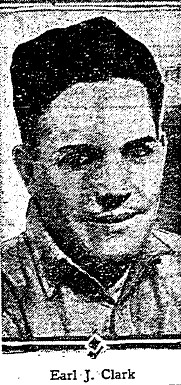 In July of 1925, Clark was sentenced to hang, but his attorneys immediately initiated an appeal to save his life. The appeal before the State Supreme Court was repeatedly delayed while Clark languished in the Los Angeles County Jail. On March 16, 1926, just days before his appeal was scheduled to come before the court, Clark and five others escaped from jail. While the five were quickly captured, Clark managed to go into hiding for over nine months. He was finally found in Minot, North Dakota, the proprietor of a paint store across the street from the local police station and husband to the daughter of one of Minot’s leading citizens.
In July of 1925, Clark was sentenced to hang, but his attorneys immediately initiated an appeal to save his life. The appeal before the State Supreme Court was repeatedly delayed while Clark languished in the Los Angeles County Jail. On March 16, 1926, just days before his appeal was scheduled to come before the court, Clark and five others escaped from jail. While the five were quickly captured, Clark managed to go into hiding for over nine months. He was finally found in Minot, North Dakota, the proprietor of a paint store across the street from the local police station and husband to the daughter of one of Minot’s leading citizens. 

 And so, Baby Week in Los Angeles was born. The program began in 1916 under Wilde’s direction, with the sponsorship of the Los Angeles District Federation of Women’s Clubs and the Los Angeles Chamber of Commerce. Features included lectures, educational booths, and most importantly, a physical screening for Los Angeles children under the age of 6. By 1927, over 88,000 children had been measured, weighed, and tested for a variety of disabilities, as well as malnutrition by Southern California doctors.
And so, Baby Week in Los Angeles was born. The program began in 1916 under Wilde’s direction, with the sponsorship of the Los Angeles District Federation of Women’s Clubs and the Los Angeles Chamber of Commerce. Features included lectures, educational booths, and most importantly, a physical screening for Los Angeles children under the age of 6. By 1927, over 88,000 children had been measured, weighed, and tested for a variety of disabilities, as well as malnutrition by Southern California doctors.

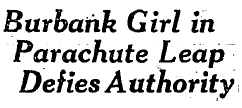 And back in the fair city of Burbank, 17-year-old Mignon Jones parachuted from a height of 2000 feet clad only in a sailor suit. Jones’s mother had discovered her daughter’s plan, and notified the police in the hopes of stopping her. However, by the time Burbank police officers arrived at the airport, Jones had already made a perfect landing and vacated the premises. She was later found at a local skating rink.
And back in the fair city of Burbank, 17-year-old Mignon Jones parachuted from a height of 2000 feet clad only in a sailor suit. Jones’s mother had discovered her daughter’s plan, and notified the police in the hopes of stopping her. However, by the time Burbank police officers arrived at the airport, Jones had already made a perfect landing and vacated the premises. She was later found at a local skating rink.
 John Gilbert, celebrated film star and sometimes paramour of Greta Garbo entered lock-up today with a sheepish grin on his face. Gilbert was arrested for disturbing the peace early on April 11 when he appeared at the Beverly Hill Police Station after a party at his home, demanding that someone be arrested. Who exactly, he wouldn’t say. When police explained they could not make an arrest without a name, Gilbert became so boisterous that he was jailed until morning.
John Gilbert, celebrated film star and sometimes paramour of Greta Garbo entered lock-up today with a sheepish grin on his face. Gilbert was arrested for disturbing the peace early on April 11 when he appeared at the Beverly Hill Police Station after a party at his home, demanding that someone be arrested. Who exactly, he wouldn’t say. When police explained they could not make an arrest without a name, Gilbert became so boisterous that he was jailed until morning.
 adies of Los Angeles! Do your cakes fall? Is your husband weary of tough pot roast? Do the words, "Company’s coming" fill you with dread? Never fear, because Mabelle E. Wyman is here!
adies of Los Angeles! Do your cakes fall? Is your husband weary of tough pot roast? Do the words, "Company’s coming" fill you with dread? Never fear, because Mabelle E. Wyman is here!
 After the first class, Wyman encouraged her audience to submit questions to a question box, and guaranteed answers either during the next class or in her "Practical Recipes" column. While most columns simply answered requests for particular recipes, others were more cryptic. One can only wonder at the query that prompted Wyman to write, "Mrs. S., Los Angeles: I am sorry but the law prohibits my either printing the recipe you ask for or sending it through the mail." Bathtub julep, anyone?
After the first class, Wyman encouraged her audience to submit questions to a question box, and guaranteed answers either during the next class or in her "Practical Recipes" column. While most columns simply answered requests for particular recipes, others were more cryptic. One can only wonder at the query that prompted Wyman to write, "Mrs. S., Los Angeles: I am sorry but the law prohibits my either printing the recipe you ask for or sending it through the mail." Bathtub julep, anyone? 
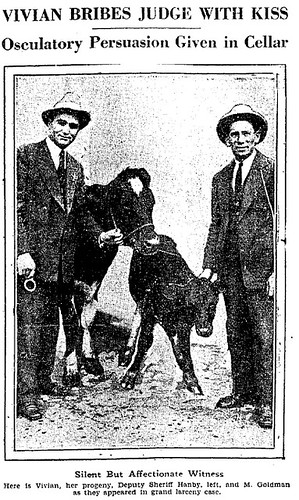 Accused of stealing four cows from Lancaster rancher J.L. Armstrong, Percy Sweet, Samuel Thomason, and Chalice Thomason first came to trial early in 1927. Due to some uncertainty about the physical appearance of the stolen cows, however, the jury was unable to reach a verdict for the suspected cattle rustlers.
Accused of stealing four cows from Lancaster rancher J.L. Armstrong, Percy Sweet, Samuel Thomason, and Chalice Thomason first came to trial early in 1927. Due to some uncertainty about the physical appearance of the stolen cows, however, the jury was unable to reach a verdict for the suspected cattle rustlers. 
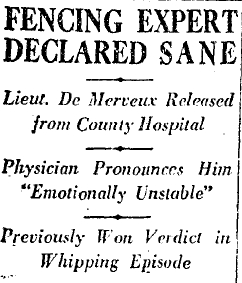 Today, fencing master and underwear salesman Lt. Gerard De Mereux was vindicated for the second time in the space of a week. Last week, De Mereux was awarded $500 in damages in a suit against Hollywood director J. Stuart Blackton, who was accused of beating De Mereux with a horsewhip. De Mereux had been living as a guest in Blackton’s home, giving fencing and corrective gymnastics lessons to Blackton’s daughters.
Today, fencing master and underwear salesman Lt. Gerard De Mereux was vindicated for the second time in the space of a week. Last week, De Mereux was awarded $500 in damages in a suit against Hollywood director J. Stuart Blackton, who was accused of beating De Mereux with a horsewhip. De Mereux had been living as a guest in Blackton’s home, giving fencing and corrective gymnastics lessons to Blackton’s daughters.